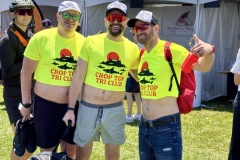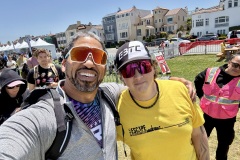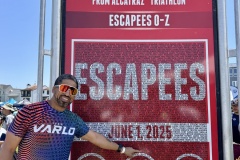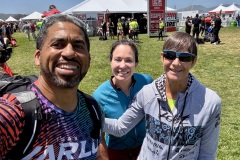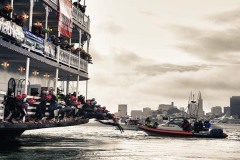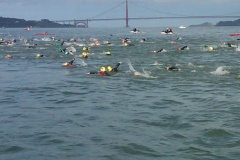The Backstory: This was my second time racing in the Escape from Alcatraz Triathlon. Two years ago, my main motivation for participating was the opportunity to swim across the San Francisco Bay. After the swim, I biked and ran like a tourist, taking in all the sights. While the course was unique and beautiful, I said after finishing that I never needed to race it again.
Then, late last year, one of the guys in my triathlon club told me that he was going back and said I should race it too(or maybe he just informed me that he was racing, and I interpreted that as a challenge). Since I’m unable to decline a challenge, I put my name in the 2nd chance lottery because the names from the primary lottery had already been chosen. I was lucky and got a slot. After registering, I set goals for the race. The first was to race it, rather than approach it as a tourist. The course is challenging and presents an opportunity to push beyond my comfort zone, testing my fitness and mental resolve. Secondly, the hills would be a good trial of my new bike gearing for climbing practice in preparation for the elevation at Ironman Lake Placid.
Working with my coach, I entered the race with a specific plan and felt excited to execute it.
| Race Goals | |
| Swim (1.5 miles) | 48min 49sec |
| Bike (18 miles) – | 1hr 09 min 27 sec (with average of 225 watts) |
| Run (8 miles) : | 1 hr 17 min 53 sec (with average of 300 Watts) |
| A 50-minute improvement | 2023: 4 hr 28 min 26 sec |
Race Day!
Transition opened at 4 am. I arrived at 3:50, and was greeted by a line of at least 200 athletes waiting to get in. Once inside, I set up fairly quickly, used the bathroom, and got on the shuttle to the dock at about 5:00 am. At the pier, I took my time changing into my wetsuit and put my morning clothes in the b’/lag when I realized that I’d forgotten to leave my bike and run nutrition in transition. There was no way to get back, so I shoved everything into the pockets of my race kit and boarded the ferry around 5:30, feeling very anxious.
Once on the ferry, I found an open spot against a wall in the rear of the second level and settled in for the next hour. The 5:45 a.m. ferry departed, full of eager athletes. This time, I recognized a few people—some from the previous run in 2023 and several more from team Varlo or Instagram. At 6:15 a.m., I drank a Peach Ketone IQ, along with caffeine and UCAN gel, while continuing to sip from a bottle of water. Then, at 6:45 a.m., I took a PFH gel with caffeine.
The current was swift that day, around 3.3 to 3.5 knots, so the captain informed us that we wouldn’t be positioned immediately off Alcatraz. Instead, we’d be a bit closer to San Francisco for safety. I learned that the professionals had experienced the same situation the day before. Although I was a bit disappointed, I was still excited about swimming approximately a mile and a half in the 56-degree water of San Francisco Bay.
I was fortunate to sit next to a woman who was attempting the race for the first time. She was from Idaho and quite nervous. We chatted, and I asked her about her main concerns. She mentioned the water temperature, the fear of swimming too far at the back of the pack and getting lost, and worries about sea life potentially attacking her. Since I had done this event once before, I shared my experience and how I approach the swim. I reassured her that there would be plenty of safety boats and personnel on the water monitoring us and looking out for any stray swimmers. If anyone gets into trouble, they can grab a kayak or a paddleboard and ask for repositioning if necessary; that is allowed, and it won’t lead to disqualification.
I also gave her tips on warming up before jumping in—suggesting that she pour water into her wetsuit a few minutes beforehand and have someone blow air into the sleeves. This way, the water inside the wetsuit would quickly warm up to her body temperature, serving as a buffer against the cold water, similar to a SCUBA diving technique I learned while wreck diving in Lake Superior during the winter. This seemed to significantly alleviate her fears.
6:45 the captain gave the 15 minute warning and instructions on how we would jump off the ferry. We all got up, zipped our wetsuits and got in line. I spotted Jeff, the triathlete and coach, who is a member of my local triathlon club, and got in line with him. Yesterday, I shared that I had a dream that I jumped off and swam from the ferry with him and there we were! We walked to the exit and in an instant took the plunge. As expected, the water was cold, but did not take my breath away. Perhaps because I poured the water in my suit first. Although not the best for sighting, I wore the FORM smart goggles. I wasn’t very confident that I would sight the buildings well (I didn’t last time), and didnt’ want to end up too far off the beach (which I did last time). In addition, I enabled the compass (swim straight function), pace, stroke rate, and HR on the displays so I could monitor my effort. I planned to push hard and stay in zone 3 for the entire swim.
Although the water was choppy, I immediately felt the speed of the current, I began swimming easily, just to settle in and find a rhythm and my pace was sub 1:15/100! I didn’t know how long I’d be in that current, so I focused on keeping my legs and hips up, my stroke rate from getting too relaxed, and just going for it. The low clouds and chop made sighting more difficult. The in-goggle compass was useful, but the main pack was heading further west (towards the Golden Gate bridge) than south as I had planned, which made me second-guess my approach. With the current pushing us so quickly, I was concerned about overshooting the beach, so I chose to head more south than west with the intention of hitting the shore and having to swim west along the shore and thereby avoiding the possibility of missing the exit point. I got multiple mouthfuls of water but didn’t swallow much at all. My teeth were aching because they were too cold from the water. The rest of my body was fine. My hands were exposed, but no numbness developed in my fingers. I noticed that my HR was hovering around 140-145 bpm which was comfortable exertion. I was breathing heavily, but never felt short of oxygen which was important since the chop would interfere with an occasional attempt at breathing. If I missed a breath, I put my head in and attempted after two more strokes and was fine. I stopped a few times to verify my heading ( I also used the kayaers as guides since they were flanking the pack). As planned I was on my planned heading. After getting close to shore, I was directed by a paddle boarder to head directly west so that I wouldn’t get close to the rocks. Feelign excited, I thought I was “just up” from the beach. However, as soon as I turned to head west, my pace dropped from abotu 1:30/100 to 3:05/100! Apparently, I found a counter current. so for 10 minutes I swam along the shore thinking I was close and would hit the beach in a minute or two only to realize I had barely moved forward. Rather than getting discouraged, I accepted that I had chosen this line and now had to stay focused until the end. I could see streams of swimmers hitting the beach, and I felt all of the progress just slipping away. Eventually, the current changed again and I managed to hold a 1:45/100 pace for the final few hundred yards. Whew, I was happy to be out of the water. Howver, it was cold and windy, so I hesitated to remove my wetsuit. We still had a half-mile run from the beach to transition. Ultimately, running in a wetsuit would be too difficult, so I shed it and headed off to T1.
During T1, putting on my socks and gloves was quite challenging because my fingers were still numb, and my toes were cold. I had to sit on the ground to manage getting everything on and to take my PFH gel.
I was excited to tackle the hills and push my body to warm up. However, on the flat road leading out of T1, I realized that my front derailleur wasn’t functioning. This meant I would be stuck in the small chainring. While that was manageable for all the climbing the course presented, it was frustrating for the flats and descents. Even when I shifted the rear into the smallest ring, there was too much cross-chaining, causing the chain to rub loudly against the derailleur. I was concerned that applying too much power might damage the drivetrain, so I decided to ease off and let gravity assist me on the downhill sections. I would push as hard as I could on the flats, but I knew it wouldn’t yield much speed in the small chainring.
Since I had adjusted my gearing in preparation for Ironman Lake Placid, climbing the hills was easier than I remembered. I focused on maintaining smooth power rather than creating big spikes and burning out during each ascent. My recent training camp in Lake Placid had paid off; I overcame my paralyzing fear of descending. I didn’t experience any anxiety as I approached the descents. Although I was ready to descend faster than usual, I encountered a twitchy front wheel whenever I hit speeds of 22-25 MPH due to gusts of wind, which were unsettling, so I rode the brakes anyway.
While I could climb faster than many cyclists around me, they all zipped past me on the descents. I spotted several Team Varlo athletes as well as my local friend, Jeff from Pearland. Overall, I enjoyed the challenge presented by the course and took in all the beautiful views along the coast. Although I was disappointed that I couldn’t push my target power, I accepted that we do our best with the conditions we face.
I arrived at transition 2 (T2) feeling great. My legs were not tired, and I had properly fueled during the ride. Before heading out onto the run course, I took a ketone shot and a caffeinated gel.
As I started running, I noticed that my toes and the front of my feet were numb. Fortunately, the first two miles were on concrete and some gravel next to the ocean. I decided to remove the pace and distance fields from my watch face. My plan was to run within a power range of 290 to 310 watts while monitoring my heart rate and paying attention to how my body felt. It has become very important for me to develop an understanding of the effort indicated by the technology and how it feels in my body. This awareness helps me know when to push harder or when to pull back during an event or training session.
For this event, holding the prescribed power felt a bit intimidating, but it was the plan. I looked forward to the moment in the run when fatigue sets in and maintaining the same power becomes uncomfortable. Typically, this is when I start to doubt my abilities, ease up, and end with regrets. But today was not going to be one of those days. My mantras were: “Push to Discomfort,” “Self-doubt is not allowed,” and “Trust the plan.”
The first two miles felt good; my body warmed up, my feet regained their sensitivity, and what felt like 300 watts was registering between 295 and 308 watts, so I was feeling confident. Continuing on, we turned and began ascending the hill that lead underneath the Golden Gate Bridge. I didn’t attempt to run up the stairs or the steeper inclines of the hill due to the lines of athletes going up and down, which made jumping in and out difficult.
The next section was quite enjoyable. We ran along a single track past old structures and through a small tunnel, continuing to climb a bit more before running along the bike course. From there, we turned and took a trail down to the beach, ran out and back on the sand, and passed through the mile 4 aid station. After leaving the beach, we headed back up the hill and climbed the infamous 200-step Baker Beach Sand Ladder.
After conquering the Sand Ladder, I was excited to discover that the last 3.5 miles were all downhill! We retraced our steps back from Baker Beach, where the vibrant atmosphere of fellow competitors finishing their runs surrounded us. I’m not an elite athlete—typically, I find myself in the middle of the pack—but the energy on the trails was contagious!
While I enjoyed the downhill, I had to switch between running and walking due to the crowd. Once we connected back to the coastal trail, I was determined to hit my power target again. During the stretch from miles 6 to 7, I felt strong and concentrated on my cadence, breathing, and form. The final segment from mile 7 to the finish was the toughest, but instead of easing up, I picked up my pace, pushing my heart rate up into the mid-160s. This was the exhilarating challenge I had been seeking, and my resolve to push through the discomfort only grew stronger. I had no idea what our pace was, and refused to ask. I’ve realized that trying to keep a specific pace messes with my head, and I’m easily thrown off and discouraged. What mattered was my effort. I was in a hard, but manageable place.
I ran alongside another competitor from my age group all the way until just a few hundred yards before entering the finisher’s chute. At that moment, my right hamstring cramped, but a quick stretch helped me power through to the finish line. The chute was alive with enthusiastic spectators, their energy making all the pain fade away. Crossing that finish line was an incredible moment—I felt an overwhelming sense of pride in my effort and the journey I had just completed!
Not only did I achieve my goal of finding and holding a difficult effort, but I smashed my previous finish time by 50 minutes!!
| Race Results | |
| Swim (1.5 miles) | 38min 18sec |
| Bike (18 miles) – | 1 hr 22 min 12 sec (averaged 179 watts) |
| Run (8 miles) : | 1 hr 24 min 09 sec (unknown power average) |
| Finish Time | 2025: 3 hr 37 min 24 sec |
| A 50-minute improvement !! |

